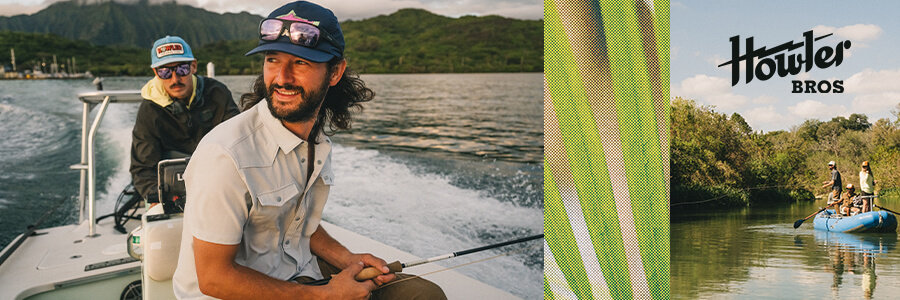Nutrient Pollution in Florida: Where Do We Go From Here?
Florida’s harmful algal blooms have a bad case of the munchies, and the only way to shut them down is to pull the plug on the state’s all-you-can-eat nutrient buffet.
Tampa Bay has always been known for its finicky redfish. Lefty Kreh used to say, “If you want to get good at bonefishing, come to Tampa Bay and go redfishing.” Chasing them on fly can be a bit of a challenge, but that’s not fora lack of fish—at least it hasn’t been until recently. Being such a densely populated area, they’ve always been subject to a lot of fishing pressure, so they’ve become a little bit tough to trick. Now, a different kind of pressure from the bay’s surrounding landscape is taking its toll on an entirely new level—one that’s far more serious than the stock’s stubbornness to take a fly.
For the past several weeks, a supercharged red tide has been wreaking havoc on Tampa Bay waters, causing fish kills on an unimaginable scale. Floating mullet by the millions, dead dolphins, manatees washing ashore, half-grand Goliath grouper getting hoisted out of the water with a front-end loader—this red tide event is nothing like what locals are used to when it comes to the unwelcome (albeit, familiar) visitor.
Captain Dustin Pack, local fly guide and member of the Board of Directors for Tampa Bay Waterkeeper, says, “What we’re experiencing right now in the bay when it comes to fish kills and red tide is something that I’ve never seen anything remotely close to.” Cleanup crews have already removed over 1,700 tons of dead marine life and debris from the bay. And that number doesn’t show any signs of slowing either, as the emergency fleet of repurposed shrimp boats continue to comb the waters. It’s an event that takes a toll on more than just the physical ecosystem, one that has cascading effects on the entire community and the millions of people that depend on the estuary. Pack understands that all too well, explaining, “As a guide, when you have a fish kill like this, nobody wants to go in the water. It’s a trickle effect—everything revolves around this waterway, this estuary, and if it’s dead, then everything dies with it.” Now, red tide (Karenia brevis) is nothing new for Florida’s gulf coast and the Tampa Bay area. The harmful algal blooms are something that many coastal residents are familiar with and have experienced in the past. What makes this current situation different— and utterly devastating—is the sheer magnitude and intensity of the bloom. So,why has this event been orders of magnitude more destructive to the estuary than other events? The short answer—nutrient pollution.
Algal blooms, like red tide, feed on nutrients in the water, primarily nitrogen and phosphorus. Unfortunately, the blooms aren’t picky where those nutrients come from, and there’s an abundance of excess nutrients flowing into the water from the land. Those nutrients—which come from a variety of sources—aren’t natural to the marine ecosystem. They’re pollution, supplementary to the naturally occurring marine nutrients, and the blooms are able to use them as fuel to grow to unnatural levels. That’s what we’re seeing in Tampa right now, a human-fed catastrophe.
In Tampa Bay, the waters already endure problematic nutrient loads from urbanbased sources such as outdated stormwater infrastructure, inadequate sewage systems, and fertilizer runoff, so when you compound those with acute incidents like the Piney Point disaster, the current red tide levels should come as no surprise. Back in April, the state declared an emergency when there was a breach in the liner of a phosphogypsum stack at an old phosphate mine known as Piney Point, releasing over 200 million gallons of nutrient-rich wastewater directly into the bay at Port Manatee in order to prevent a total collapse of the stack.Now, Capt. Pack is seeing his home waters suffer from the consequences he hoped wouldn’t manifest but knew were likely, remarking, “215 million gallons is going to push any estuary over the top when it comes to nutrient load.” This endless assault of nutrients entering the water is like dumping gasoline on a forest fire, a direct pipeline of fuel to supercharge a natural occurrence into something other-worldly. Unfortunately, it’s not at all unique to Tampa Bay—it’s happening all over the state.Tampa may be experiencing the worst of it right now, but waterways throughout Florida are feeling the same heat, and they have been for years. The nutrient pollution that fuels these events is a statewide crisis, and it’s threatening the lifeblood of the state—clean water. The Caloosahatchee River Estuary, Indian River Lagoon, Mosquito Lagoon, Charlotte Harbor, Lake Okeechobee, Biscayne Bay, they all suffer from heavy nutrient pollution that’s pushing them towards the brink.
The sources of nutrients and the impacts that ensue may vary from waterway to waterway, but it’s all the same root issue—too many nutrients. In Lake Okeechobee, it’s largely fertilizer runoff from industrial agriculture around the lake that takes toxic blue-green algae to unfathomable levels. In the Caloosahatchee, the biggest threat to the estuary comes from the high-volume Lake Okeechobee discharges, which carry nutrientladen lake water out to the gulf where red tide blooms can use it to intensify and increase in duration. Mosquito Lagoon has lost most of its seagrass to brown algae that feeds on nutrients from seeping septic tanks, sewage spills, and stormwater runoff. Biscayne Bay suffers from urban sources of nutrient pollution similar to those of Tampa Bay. The list goes on.
The good news is that there is hope—there are paths to solving these issues and keeping the nutrients out of the water, but it’s going to take a great deal more public involvement to see solutions implemented. Ultimately, it’s going to take major legislative reform at the state level. The state needs to create new, meaningful policy that prioritizes water quality, addresses the pollution at its source, and holds polluters accountable. Jessica Pinsky, Director of Policy for Captains For Clean Water agrees, adding, “We have a lot of catching up to do in Florida when it comes to policy pertaining to nutrient pollution in our waterways. We need an executive branch that will be the enforcer of the law, a legislature that does not bow to the will of special interest groups, and water management districts that prioritize protecting and cleaning our water resources.”The only way that’s going to happen is if more people are made aware what’s going on. People can’t care if they don’t know what’s
happening, and policymakers are never going to care if the public doesn’t care. The state legislature needs to feel public pressure on
these issues. If they don’t, they’ll just keep kicking the can down the road, like they did this past legislative session.
To make progress on addressing the issue, the next step for the state legislature is to fully implement the recommendations of the Blue-green Algae Task Force into enforceable legislation. They had an opportunity to do just that during this past legislative session, but they elected not to. That’s why we need everyone to get involved and demand better for our waters. Whether you live in Florida or just like visiting, it’s all the same—we all need to fight together for these threatened ecosystems. It all creates pressure on our elected officials to do what’s right. So, stay involved, learn more about the issues, spread the word with your friends, and bring others into the fold—we’re going to need an army for this fight. Things might not change overnight, but with enough people, we can make real progress and save our waters.




